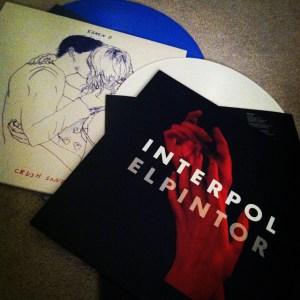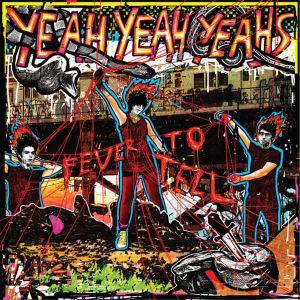I bought Interpol’s Antics the day it came out in September 2004. I was 12 years old.
It’s astounding to me that, ten years later, I did more or less doing the same thing I was doing as a 12-year-old – buying an Interpol album the day it was released on a cool September evening. There are a few differences: My parents didn’t have to drive me to Best Buy to pick up El Pintor; I bought the vinyl version instead of the CD version; I’d already heard all of El Pintor, whereas I was only familiar with “Slow Hands” before buying Antics.

September 9’s purchases.
Essentially, I am same person I was as a 12-year-old, just with more experience, a driver’s license and a Spotify account.
El Pintor was one of the albums I was most psyched for this year; it’s the first one where I made plans with myself to buy a physical copy. My quest to pick up Interpol’s fifth album wasn’t just a casual “I’ll-stop-on-my-way-home-from-work” errand. Instead, I decided to go to a record store I hadn’t gone to before in a neighborhood I’m only beginning to get familiar with.
I made this quest an experience, something that will (hopefully) stick with me.
Even this, though, is not that different from the day I purchased Antics. Throughout middle school, I was great at convincing my parents to take me on Tuesday nights to Best Buy or Target or the Exchange or Quonset Hut (shopping local!) to pick up newly released CDs. I could never wait – I had to be among the first to own an album. I had to be the first to hear it. The day I bought Antics was quintessential me; I convinced my parents that I had to go buy this album and off to Best Buy we went. (Luckily, my parents were usually supportive of my insane desire to own every album that came out every Tuesday.) Antics was on a front display, and I all but ran to it. However, my eagerness to grab that album instantly isn’t the important part: It’s what I did once I had it in hand. If you look at the CD cover for Antics, the title and INTERPOL are written on the top and bottom in huge black and red letters. (Note: I have the white album artwork, not the black.) It’s much harder to read the album title and artist on the sides because of the jewel casing.
Realizing it was hard to read, I purposely carried the CD throughout Best Buy – as my dad perused through some other albums and then movies – so that the top and bottom were facing out. So that anyone who walked by me in Best Buy could see the album I was carrying around. So that, even at 12, I could demonstrate my wicked, authentic indie cred.
Antics wasn’t the only album that I bought in 2004 that revealed a lot about my developing taste in music. From 2004 through 2006, I bought some of the most important albums in my collection – all compact discs at the time, of course – and I also bought a lot of trash I’ll never spin again. The trash doesn’t matter to me anymore; it’s the albums that had staying power without me realizing that they would have that power that I can’t stop thinking about. How did 12-year-old me know?
As it happens, a few things were happening in 2003 and 2004 that drove me to albums like Antics. MuchMusic, the television channel, became Fuse; their music video offerings suddenly decorated my sleepless nights. Starting when I was about 10, I was waking up almost every night and walking down a short flight of steps to sleep on the family couch. I could speculate a thousand reasons why I kept waking up and why I stayed up, but that’s another post. I would lie on the couch and turn Fuse on, knowing they would reliably be showing music videos. It was on Fuse I first saw videos including The Strokes’ “12:51” and The Vines’ “Get Free.” (The Vines’ Craig Nichols scared me for a while, truth be told. I thought he had dead eyes. Real story.) Watching Fuse made me excited for music videos; I started to look forward to certain ones and would challenge myself to stay awake until they played.
Then, in 2004, my aunt subscribed me to Spin – as I’ve written about before. Spin became my primary information source, and the bands I was reading about in Spin would show up on Fuse. I not only could read about all of these bands’ activities, their upcoming albums, their recent performances – but I could have an immediate taste of them just by turning on my TV. I suddenly had something that felt so much cooler than what most of my friends in Catholic school were listening to.
It’s why I decorated my locker with pictures of Interpol, Arcade Fire and Yeah Yeah Yeahs (in addition to some hilariously bad quality prints from Donnie Darko). It’s why I incorporated the albums I was purchasing into the still life drawings I was creating in my seventh grade art class (also a true story). I had no concept of just how earth shattering these bands were to the rest of the world, not even with some context from Spin; I didn’t think of them in a post-9/11 sense for a long time. I didn’t understand the resonance of “NYC” until years later. Instead, I heard these bands as something so different from the banality of suburban Ohio Catholic schooling that I was familiar with. The sound of the bands was everything; I don’t know how, but I knew it was important. I knew it mattered.
I bought Fever to Tell in a Walmart in Canton, Ohio. I don’t remember the date like I do with Antics; I just know it was still sometime in middle school (it might have even been right before Antics). I decided I had to have it after watching a Yeah Yeah Yeahs performance on cable. Karen O was captivating and everything I wanted to be. She was the ultimate alternative to what I knew, even compared to my previous obsessions with popstars like Britney and Christina. “Maps” was a good song with a cool video, but seeing them perform and hearing the frenetic energy of the rest of their catalog convinced me I needed the album experience.

Probably not the edited version.
Dude at Walmart wouldn’t give me the full experience. I grabbed a copy of Fever to Tell, and he immediately advised my mom that this album would be “bad for me.” I believe he asked something along the lines of, “Do you know what she’s singing about?” I just shrugged and gave him a look that said, “Don’t you understand I’m 12 and need this album?” He was unrelenting, but so was I. Our hilarious compromise resulted in me owning the edited version of the album WHICH STILL PISSES ME OFF TO THIS DAY.
Anger aside, though, I owned Fever to Tell. Yeah, some words are definitely edited out, but the music is unchanged. The sound matters; the energy and intensity are still intact. Karen is still belting out (98% of) her lyrics. I knew all of the words to “Date with the Night” within a week.
The edited version of Fever to Tell is still in my car.
I bought Karen O’s Crush Songs when I bought El Pintor. I am the same person I was when I was 12 years old, just with more buying power and a better understanding of what I’m getting.
I realized in May that Antics is still one of my favorite albums. I know, I know: Everyone loves Turn On the Bright Lights, and Interpol will never have another album like it. Whatever. While I also love that album (“PDA” is one of my all-time favorites), Antics is so important to me. I realized it when I was driving home from work and “C’Mere” came on. I was basically screaming along with it driving down the highway, and that was when it hit me: I’d known the words to that song for 10 years but had never really thought about what they meant. “I had my doubts little girl/I’m in love with something real” is one of my favorite lyrics. Why was it only now resonating with me in May 2014?
Because at 12 years old, I cared about the sound of “C’Mere,” not what it was saying. I cared about what Interpol represented as a status symbol and as something fashionable. I knew liking Interpol made me something different, if only in some small way. And, for a long time, repeated listens of Antics mostly just reminded me of how I felt in middle school. That day this past May, when I caught myself howling along with “C’Mere,” was when I realized that the album I bought as a 12-year-old was actually providing a soundtrack to things that were happening in my life at 22 that I would have never understood ten years ago. Antics, I realized, is a timeless album for me. Instead of reminding me of middle school, now, it’s evolved into a record that I hear in the present and relate to the present.
El Pintor is going to have a similar life cycle. It’s the soundtrack to my first summer in Cleveland; I’m going to associate it with sitting along Lake Erie and my sunny morning commutes and my late nights in Lakewood. It’s going to take time for El Pintor to grow into the timeless document that Antics is. However, I also know that a year from now, five years from now, “All the Rage Back Home” is going to be just as exciting to me as it is now.
I don’t know that Crush Songs will have the same lasting power; in fact, I don’t think it will at all. But for me, right now, Crush Songs is exactly what I want to (and in some cases, need to) hear. And, listening to it later on, I know I’ll be reminded of this summer specifically, of graduating from college and moving to Cleveland and everything that entailed. Karen O. is crafting something that I will always associate with the dog days of summer 2014. Just like Fever to Tell reminds me of middle school, Crush Songs sounds like the beginning of adulthood.
I’m the same person I was when I was 12, and now I’m going to stream this new Julian Casablancas album.

